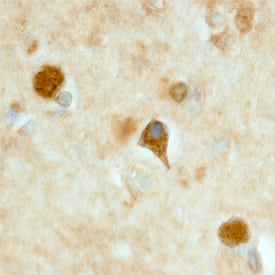Human/Mouse LRRTM3 Antibody
R&D Systems, part of Bio-Techne | Catalog # AF4898

Key Product Details
Species Reactivity
Applications
Label
Antibody Source
Product Specifications
Immunogen
Glu31-Lys419
Accession # Q86VH5
Specificity
Clonality
Host
Isotype
Scientific Data Images for Human/Mouse LRRTM3 Antibody
LRRTM3 in Human Hippocampus.
LRRTM3 was detected in immersion fixed frozen sections of human hippocampus using Human LRRTM3 Antigen Affinity-purified Polyclonal Antibody (Catalog # AF4898) at 15 µg/mL overnight at 4 °C. Tissue was stained using the Anti-Sheep HRP-DAB Cell & Tissue Staining Kit (brown; CTS019) and counterstained with hematoxylin (blue). Specific staining was localized to neurons. View our protocol for Chromogenic IHC Staining of Frozen Tissue Sections.Applications for Human/Mouse LRRTM3 Antibody
Immunohistochemistry
Sample: Immersion fixed frozen sections of human hippocampus
Western Blot
Sample: Recombinant Human LRRTM3 (Catalog # 4898-LR)
Formulation, Preparation, and Storage
Purification
Reconstitution
Formulation
Shipping
Stability & Storage
- 12 months from date of receipt, -20 to -70 °C as supplied.
- 1 month, 2 to 8 °C under sterile conditions after reconstitution.
- 6 months, -20 to -70 °C under sterile conditions after reconstitution.
Background: LRRTM3
Human LRRTM3 (leucine-rich repeat transmembrane neuronal 3) is a 63 kDa (predicted) type I transmembrane protein, and one of four members of the LRRTM family of proteins within the leucine-rich repeat (LRR) superfamily (1). There are two isoforms of LRRTM3. Isoform 1 is synthesized as a precursor with a 30 amino acid (aa) signal sequence, a 389 aa extracellular region, a 21 aa transmembrane region, and a 141 aa cytoplasmic region. In isoform 2, aa 513 is changed from isoleucine to valine, and aa 514 to 581 are missing, producing a cytoplasmic region of only 74 aa. The extracellular region of both isoforms contains one N-linked glycosylation site, a leucine-rich repeat N-terminal domain bordered by four conserved cysteines, and 10 LRRs flanked by cysteine-rich domains (1). The cytoplasmic region of both isoforms contains several tyrosine, serine, and threonine residues that have the potential to be phosphorylated, and thus to be involved in signal transduction (1). The C-terminal of isoform 2 also contains a conserved glutamic acid-cysteine-glutamic acid-valine sequence for potential interaction with PDZ proteins (1, 2). Mature human LRRTM3 (isoform 1) is 98% identical to mouse LRRTM3. In the mouse, beginning at 8.5 dpc, strong levels of LRRTM3 can be detected in the neural progenitors of the neural plate that will develop into the rostral neural tube, the forebrain, a stripe in the hindbrain, and the region of the presomitic mesoderm/somite boundary (2). By 15 dpc, LRRTM3 is expressed broadly and accumulates thereafter (3). In the adult, LRRTM3 is expressed almost exclusively in the brain with high expression in the cortical laminae and dentate gyrus, as well as detectable levels in the hypothalamus and amygdala (3). Functionally, LRRTM3 may be involved in the formation of the CNS and maintenance of CNS structure and function in the adult brain (1). In addition, LRRTM3 has been shown to promote processing of amyloid-precursor protein by BACE1, and is a positional candidate gene for late-onset Alzheimer’s disease (3).
References
- Lauren, J. et al. (2003) Genomics 81:411.
- Haines, B.P. and P.W.J. Rigby (2007) Gene Expr. Patterns 7:23.
- Majercak, J. et al. (2006) Proc. Natl. Acad. U.S.A. 103:17967.
Long Name
Alternate Names
Gene Symbol
UniProt
Additional LRRTM3 Products
Product Documents for Human/Mouse LRRTM3 Antibody
Product Specific Notices for Human/Mouse LRRTM3 Antibody
For research use only
